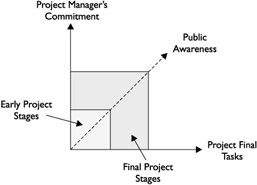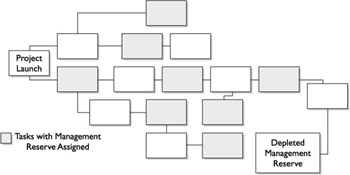Completing the Final Tasks
Completing the Final Tasks
When you begin to see the final tasks coming into focus, it is not a signal to ease off of the project team and the project. Some project managers make the costly mistake of allowing the project to finish under the guidance of a team leader or have too much faith in the project team to complete the tasks. These project managers allow themselves to relax, begin looking for new projects to lead, or begin their efforts to prove that Microsoft s FreeCell game 11982 can be won.
The problem with relaxing as the project is nearly completed is that the project team will follow your lead and relax as well. Project managers have an ownership of the project that sometimes leads them to believe they are superior to the project team and have permission to put their feet up. As the project team sees the project manager ease out of meetings, out of sight, and out of focus, they ll follow suit and do the same, as Figure 12-1 demonstrates .

Figure 12-1: The project team will follow the project manager s actions.
In the final stages of project, a project manager must actually do more to motivate and communicate with the project team. A project manager must attend every meeting as she s done throughout the project. She needs to get into the trenches and work with the team members to help them complete the work and keep them moving to complete the project on time. A project manager needs to discuss any final issues with the team, with the client, and with management. A project manager s presence is obviously required throughout the project, but even more than usual during the final chunk of the implementation.
Going the Distance
What is, unfortunately , more typical of project managers than easing off an on-track project is working in a frenzy to complete a project that s gone awry. For example, consider a project that has had six months to complete the implementation of a new e-mail client, develop workflow forms, and convert the existing e-mail servers. In this scenario, the final tasks are the most critical in the entire project. All of the prep work, research, and design has led the project team to this moment. The switch from old to new is when the curtain comes up and everyone in the company will see your work, your design, and your implementation. As Figure 12-2 demonstrates, these tasks, close to the finish, are the revelation of your ability as a project manager.

Figure 12-2: The final tasks in a project require the project manager s full attention.
That fact becomes quite evident when the project team and the project manager realize they are not prepared to complete the project on schedule. Now the project manager looks for ways to speed up the process to complete the job on time. This usually means additional hours, nights, and weekends. Be prepared to work the hardest in the final days of a project s implementation if the project is off schedule even by just a few days.
The secret here is to control your emotions, the project team, and any other parties who have volunteered to help with the final tasks. If the folks looking to you to complete the work see you losing control, getting angry , and cutting corners, they ll do the same. Cool heads always prevail.
When you find yourself with a huge amount of work to complete in just a few hours, here are a few guidelines to being successful:
-
Remain cool, calm, and collected. Set the example for your team; think clearly, but quickly.
-
Get organized and treat the final work as a mini-project. Analyze the work to be completed, break down the tasks, and set the plan into action. Create a map of the final implementation in a central war room and color code the completed tasks.
-
Communicate with the team members, but don t get in the way of their completing tasks.
-
If you re visiting multiple workstations, organize a method to visually represent the completed work. For example, if a workstation has been prepped for a new installation, put a red sticky note on the monitor. Once the workstation has been completed, put a green sticky note on the monitor. At a glance, anyone can see the status.
-
Check for quality. Periodically take a sampling of the work to confirm that what you are attempting to deliver on time is the quality you and the end user will expect.
-
Work in shifts. If your team must work around the clock, which is not unheard of, break up the team in shifts so that the team can get some rest and be refreshed. It s tempting to have the entire team on the final phases of an implementation, but as the entire team wears down, the quality of the work suffers.
Examine the Critical Path
As the project begins to wind down, take a close look at the critical path to determine that the tasks to completion are in order, and confirm that the team members who are assigned to the tasks are still motivated. In your team meetings, review the upcoming final tasks to reinforce the importance of their completion. Team members will likely be as excited to complete the project as you, so offer a little urging to continue the momentum to finish.
Within the network diagram, trace the history of the successor paths and determine if there has been a history of tasks being late or lagging. If there is, address this issue to the project team and challenge them to complete the remaining tasks on schedule. You must do all that you can to ensure that the project team is committed, moving, and excited to complete the project.
A source of motivation can be a review of all the work the project team has completed. You can show the team the number of hours committed to the project, and how healthy the project is. Also, remind the team members of the rewards awaiting them once the project has been completed.
At the end of the critical path should be the management reserve. Recall that management reserve is a percentage of the total time allotted for all of the work within a project, usually 10 to 15 percent. Examine the management reserve to see how much time is still left for slippage. For example, a six-month project would likely have 14 to 20 days in management reserve for tasks that are lagging. In the final stages of the project, examine the balance of time in management reserve; if things have gone well, you should have a few days left in reserve. If there have been serious mistakes in the project, then all of the available days in the reserve have been used. Figure 12-3 demonstrates the application of management reserve to early tasks in the critical path, which can impact any delays in the final task of a project.

Figure 12-3: A depleted management reserve can impact final tasks.
The point is, an examination of the management reserve will give you an idea of the overall health of the project and will predict how much time you truly have to complete the work. Hopefully, you ve got a sliver of time left over to complete the project and allotted for any unforeseen troubles. In some instances, management reserve doesn t matter ”for example, when a network switch must take place over one weekend . A management reserve with two extra days won t help at all if the network has to be switched when the production is not in place.
98 Percent Done Is Not Complete
When dealing with third parties that will complete the implementation phase of your project, you really need to convey to them that 98 percent done is not complete. Far too often, integrators begin a project with gusto, but lag in the final implementation. Vendors sometimes need to be reminded a project is not complete until it is 100 percent done. You can motivate these folks with these techniques:
-
Final payment is held until the project is completed.
-
Specify the project deliverables as 105 percent to get them to aim for 100 percent completion.
-
Commit them to specific times and dates to work on the project in the final phases of the implementation.
-
Assign a task in the critical path that is a walk-through and sampling of the work they have completed. The critical path is not complete until you approve their work.
EAN: 2147483647
Pages: 195